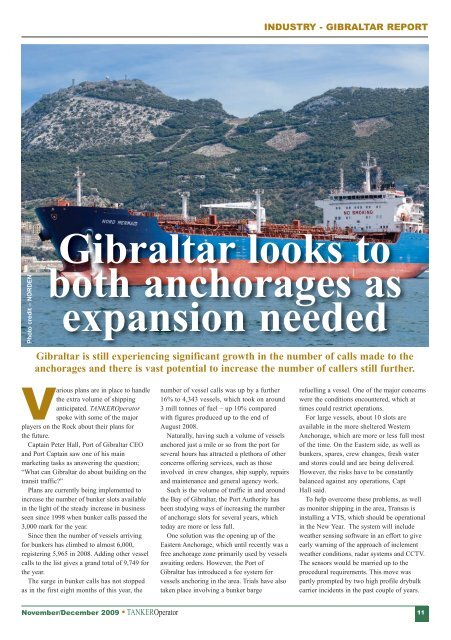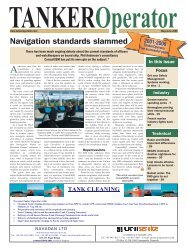Features: - Tanker Operator
Features: - Tanker Operator
Features: - Tanker Operator
You also want an ePaper? Increase the reach of your titles
YUMPU automatically turns print PDFs into web optimized ePapers that Google loves.
INDUSTRY - GIBRALTAR REPORT<br />
Photo credit – NORDEN<br />
Gibraltar looks to<br />
both anchorages as<br />
expansion needed<br />
Gibraltar is still experiencing significant growth in the number of calls made to the<br />
anchorages and there is vast potential to increase the number of callers still further.<br />
Various plans are in place to handle<br />
the extra volume of shipping<br />
anticipated. TAKER<strong>Operator</strong><br />
spoke with some of the major<br />
players on the Rock about their plans for<br />
the future.<br />
Captain Peter Hall, Port of Gibraltar CEO<br />
and Port Captain saw one of his main<br />
marketing tasks as answering the question;<br />
“What can Gibraltar do about building on the<br />
transit traffic?”<br />
Plans are currently being implemented to<br />
increase the number of bunker slots available<br />
in the light of the steady increase in business<br />
seen since 1998 when bunker calls passed the<br />
3,000 mark for the year.<br />
Since then the number of vessels arriving<br />
for bunkers has climbed to almost 6,000,<br />
registering 5,965 in 2008. Adding other vessel<br />
calls to the list gives a grand total of 9,749 for<br />
the year.<br />
The surge in bunker calls has not stopped<br />
as in the first eight months of this year, the<br />
number of vessel calls was up by a further<br />
16% to 4,343 vessels, which took on around<br />
3 mill tonnes of fuel – up 10% compared<br />
with figures produced up to the end of<br />
August 2008.<br />
Naturally, having such a volume of vessels<br />
anchored just a mile or so from the port for<br />
several hours has attracted a plethora of other<br />
concerns offering services, such as those<br />
involved in crew changes, ship supply, repairs<br />
and maintenance and general agency work.<br />
Such is the volume of traffic in and around<br />
the Bay of Gibraltar, the Port Authority has<br />
been studying ways of increasing the number<br />
of anchorage slots for several years, which<br />
today are more or less full.<br />
One solution was the opening up of the<br />
Eastern Anchorage, which until recently was a<br />
free anchorage zone primarily used by vessels<br />
awaiting orders. However, the Port of<br />
Gibraltar has introduced a fee system for<br />
vessels anchoring in the area. Trials have also<br />
taken place involving a bunker barge<br />
refuelling a vessel. One of the major concerns<br />
were the conditions encountered, which at<br />
times could restrict operations.<br />
For large vessels, about 10 slots are<br />
available in the more sheltered Western<br />
Anchorage, which are more or less full most<br />
of the time. On the Eastern side, as well as<br />
bunkers, spares, crew changes, fresh water<br />
and stores could and are being delivered.<br />
However, the risks have to be constantly<br />
balanced against any operations, Capt<br />
Hall said.<br />
To help overcome these problems, as well<br />
as monitor shipping in the area, Transas is<br />
installing a VTS, which should be operational<br />
in the New Year. The system will include<br />
weather sensing software in an effort to give<br />
early warning of the approach of inclement<br />
weather conditions, radar systems and CCTV.<br />
The sensors would be married up to the<br />
procedural requirements. This move was<br />
partly prompted by two high profile drybulk<br />
carrier incidents in the past couple of years.<br />
November/December 2009 TANKER<strong>Operator</strong> 11

















